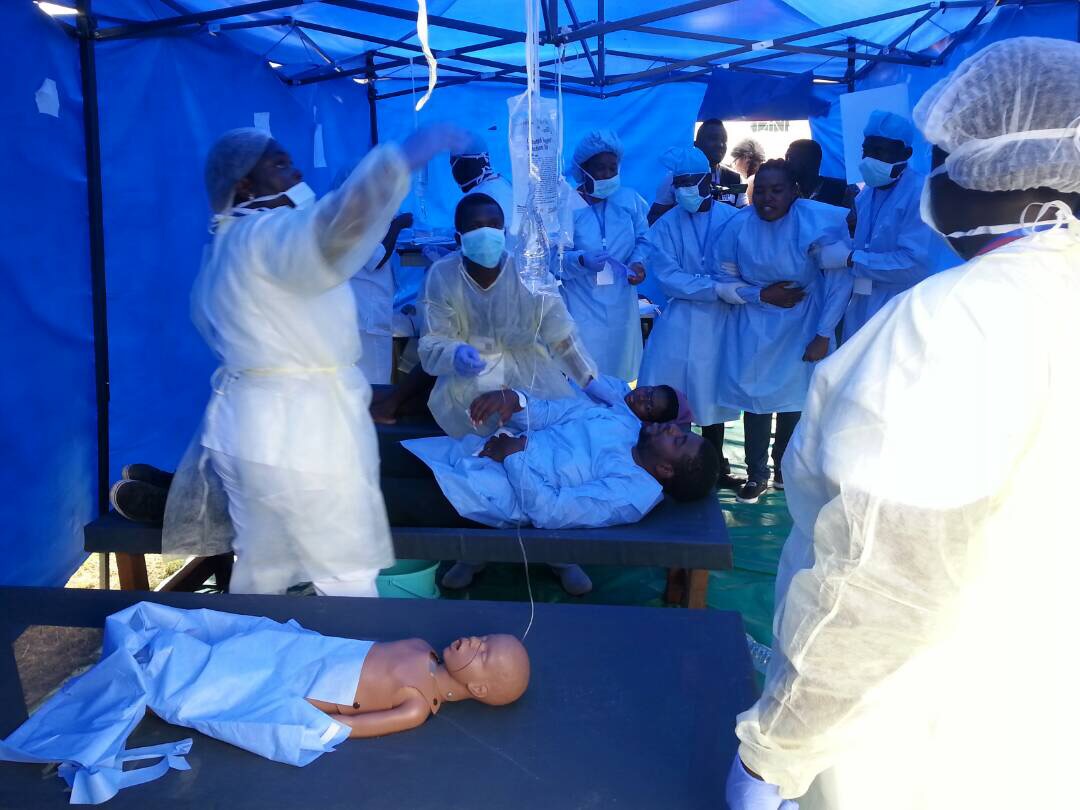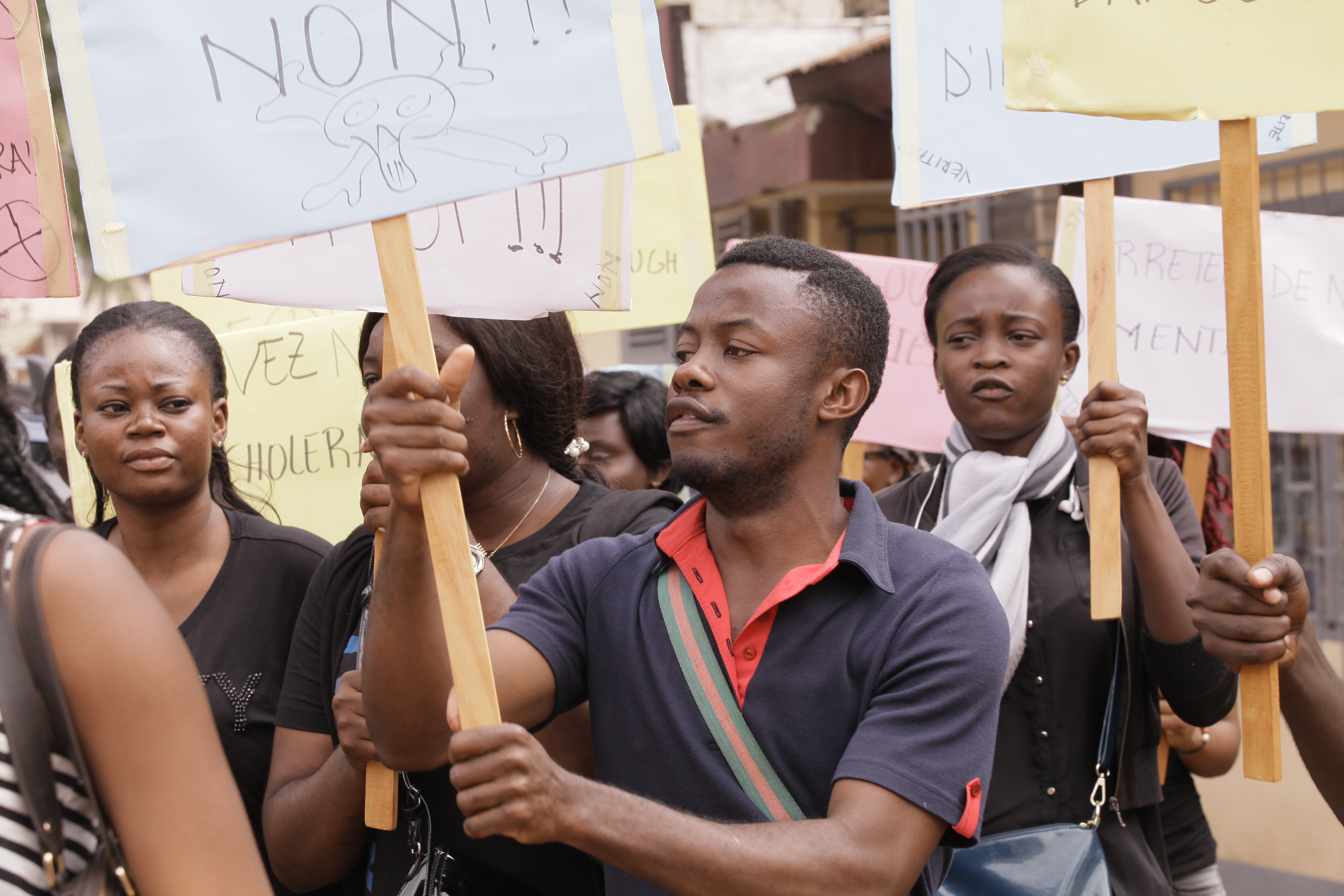First-Of-Its-Kind Exercise Tests Cameroon’s Ability to Detect, Respond and Stop Cholera ‘Outbreak’

Health care workers at Cameroon’s Laquintinie Regional Hospital in Douala evaluate and treat actors and mannequins displaying symptoms of cholera on Sept. 13 as part of a simulation testing the country’s improved ability to detect and respond to disease outbreaks.
It was a routine wedding in one of Africa’s smaller countries, an event so commonplace and unremarkable it would be easy to miss.
And yet, by the time the last remnants of the Sept. 3 wedding in Holy Trinity Parrish, Cameroon had lifted after more than two weeks, the wedding and its aftermath had drawn rapt attention from powerful people in places like Cameroon’s capital Yaoundé; Washington; DC, Atlanta, Geneva, and beyond..
The reason was that, in addition to the 250 people at the wedding, there was something else – cholera.
Or more precisely, a cholera sample carefully prepared specifically for the event.
The wedding and the circumstances surrounding it were all part of an elaborate and meticulously crafted simulation conjured and written by senior officials from the Centers for Disease Control and Prevention (CDC), Cameroon’s Ministry of Health and the Pentagon’s Defense Threat Reduction Agency (DTRA). All of them played central roles in an exercise designed to rigorously test a new set of tools and practices Cameroon has installed for quickly identifying and aggressively responding to disease outbreaks.
The rationale was substantial by itself. Yet the simulation carried added significance because it was the first, full-blown exercise of its type to take place in a country embracing the 2014 Global Health Security Agenda (GHSA), an initiative designed to create stronger, more universal protections against disease outbreaks and to close gaps that allow disease to take root and spread.
Today, more than 60 nations are part of GHSA. The initiative differs from earlier attempts by demanding greater accountability. Specific goals include greater consistency in the way laboratories perform. Partner countries also agree to improve surveillance, logistics, and the availability of trained “disease detectives,” among other requirements.
From the start, Cameroon has been an active and eager participant. With the simulation, the changes Cameroon has achieved, often in close collaboration with CDC, would be put to the test.
The test would “touch every base.” It would measure the effectiveness and readiness of Cameroon’s upgraded laboratories and sample referral. It would gauge the nation’s ability to clearly and quickly transmit crucial information and to utilize a more robust disease surveillance network. It would activate a new and streamlined process for transmitting information from the local level to regional officials and to the Ministry of Health.
Perhaps most significant of all, it would measure the speed and activation process of Cameroon’s new public health emergency operations center (PHEOC) and how well it functioned in real time.
It would assess the policies and aptitude of ticket agents at Douala International Airport who would unknowingly confront an actor presenting symptoms of cholera, trying to return home to Nigeria from the wedding. It would evaluate and grade health care workers who provided direct care to patients with confirmed cases of cholera as well as laboratory staff who received samples and conducted the crucial tests.
The simulation was launched with a cover story – a 43-year-old man is taken to the Hospital New-Bell, Douala in the early hours of Sept. 7. He has profuse watery diarrhea, vomiting, muscle cramps, fatigue, and is clearly dehydrated, all of which are possible signs for cholera. During his stay, he tells health care workers that he traveled to Douala to work for a caterer at the wedding.
With that, the most rigorous test to date begins of Cameroon’s ability to provide accurate disease diagnosis, case management, surveillance and coordination and to measure how well health officials in Cameroon were able collect information, analyze it, predict the outbreak’s scope and direction and how to effectively combat it. The exercise would also evaluate the performance of the PHEOC in the capital of Yaoundé, 143 miles away from Douala where the outbreak was centered.
Near the end of the exercise as the number of cases spiked to 45, 17 actors playing angry, sign-carrying protesters would converge on the PHEOC in Yaoundé demanding answers and action. This element, “injected” into the scenario, was designed to test the way government health officials provided information to the public in a crisis situation.
And all of it would take place under the watchful eye of more than two dozen experts from CDC, DTRA, the World Health Organization (WHO) and other organizations focusing on public health.
Conceived in May, the complicated simulation, which took place from Sept. 7-15, took months to prepare and organize. It was billed as the first international public health response exercise in Africa. Cameroon health officials were given a range of dates when the exercise could take place but they did not know precisely when the sample (which would actually test positive for cholera) that commenced the exercise would arrive at the laboratory.
By definition, simulations can only go so far. They can’t fully recreate the fear, doubt and anxiety that come with genuine outbreaks. They can’t fully replicate the relentless pressure that comes from knowing the consequences of mistakes and missteps.
This simulation tried, however. With 60 individual “injects” or elements that changed the shape and details and severity of the “outbreak,” the Cameroon exercise was one of the most elaborate ever conducted by CDC.
“We gave a lot of thought to how we could include elements that tested the full range of the response,” said Kerrethel Avery, who was CDC’s lead official for the exercise and who works in the Office of Public Health Preparedness and Response.
“That’s why we had people who came to the wedding from other countries show up at the airport to go home. It is why we included tweets and Facebook posts that prompted angry responses from the public to see how the PHEOC would respond and set the record straight. It’s why we built in a ‘time jump’ so the number of cases could spike at the same time the response was under the heaviest stress.”
Cameroon was a logical choice. One of the original 17 members of the GHSA, Cameroon has been an eager and committed participant in the ambitious program designed to close the gaps that diseases use to take root and spread, and to equip countries with the best tools for detecting, responding and preventing outbreaks.
On paper, Cameroon’s upgrades and dedication have made it a model in Africa and one of the high achievers among all GHSA partner countries. The simulation was designed to give those upgrades a near real-life stress test.
Cholera was the perfect test.
A waterborne bacterial disease that can spiral quickly out of control, it is a disease that Cameroon knows well. The first cases were reported in 1971 and there have been periodic flares ever since with the last major outbreak occurring in 2011. But the primary symptom – watery diarrhea –can be missed because diarrhea is a common fact of life in countries like Cameroon. Identifying it, and containing it, requires an alert surveillance system, strong laboratory work, clear, decisive communication and collaboration.
Cholera can move so fast and with such dangerous consequences that in Cameroon, as in much of the world, a single confirmed case qualifies as an outbreak.
Experts in Cameroon’s Emergency Operations Center in Yaoundé coordinate the response as they receive information in real time from the source of the outbreak more than 140 miles away.
“A single confirmed case of cholera is considered a medical emergency,” said Alphonse Acho, the PHEOC’s facility manager in Yaoundé.
In the exercise, the initial stool sample tested positive for cholera, in the small laboratory of New Bell district hospital. It was sent to the regional laboratory Laquintinie, in Douala, which confirmed it in less than 72 hours. By Monday, Sept. 11, the laboratory-confirmed cholera case was mentioned during a meeting of the Ministry of Health’s surveillance team. Soon after the PHEOC was activated.
As with any response, one of the most crucial moments was also one of the earliest. It took place at the New Bell laboratory where the initial sample was sent and subjected to a rapid test. Following the National Public Health Laboratory’s (NPHL) guidelines, lab technicians also had to correctly prepare the sample that was sent to the regional Laquintinie Hospital Bacteriology Laboratory for a second, more complicated gold standard test (stool culture) that would confirm the initial result.
While there were a few tense moment and small missteps, the system worked. Staff at Laquintinie laboratory correctly isolated and accurately identified cholera from the (simulated) sample, which was the essential step to declaring an outbreak and a broad, coordinated response.
Another piece that meshed was equally important – Cameroon’s improved ability to share data in real-time to all the key players.
“Having reliable data on time, place, and persons with disease is key to responding to outbreaks,” said Anne Griggs, an expert from CDC’s National Center for Emerging and Zoonotic Infectious Diseases.
“Not having the data to inform on time, place, and person impedes effective and rapid response and allows disease to spread within and across borders,” said Griggs, who served as an observer of the exercise and was a key consultant on upgrading the “informatics” system.

Actors portraying citizen angry about the incomplete information they are receiving about the cholera outbreak voice their concerns outside the EOC in Yaoundé. The simulation included this element to test the way information was conveyed to the public in a crisis situation as the response unfolded.
“Every component of the public health response effort had access to the same information at the same time,” said Jean Baptist Kamgang, an expert on information systems who was born in Cameroon but who now works in Atlanta for CDC’s Division of Global Health Protection. “This was not only a great accomplishment, but a first in Cameroon and in the region.”
Much of the response unfolded smoothly and as designed. But not everything.
There were stumbles. At Douala Airport, a thick binder outlining procedures for identifying and responding to passengers who are sick – or appear to be sick – wasn’t followed. Instead, airline ticket agents used a separate and insufficient set of rules that blurred lines of communication and treatment. That led to moments of confusion.
Even so, airport officials said the simulation was useful because it highlighted areas that needed clarity and improvement.
“You never know when the next outbreak will occur but you can’t respond well without practice,” said airport official Tsakam Sandrine. “Our way of looking at things has shifted. In the past, nobody would have asked about the airport during an outbreak response and how it can be involved in spotting or stopping outbreaks.”
The early assessments of Cameroon’s performance were positive and while more detailed and granular evaluations will be presented in coming weeks, the general view at the conclusion was that Cameroon had reached a significant milestone.
“To see how far this country has come, I feel like a proud mother watching my kids go off to college,” Avery said.